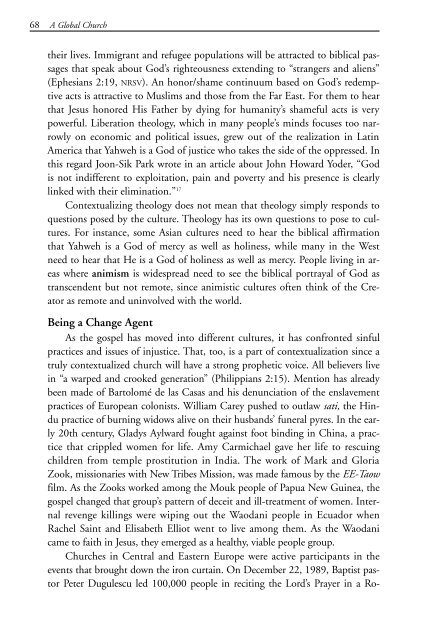discovering missions - Southern Nazarene University
discovering missions - Southern Nazarene University
discovering missions - Southern Nazarene University
You also want an ePaper? Increase the reach of your titles
YUMPU automatically turns print PDFs into web optimized ePapers that Google loves.
245187 Disc Missions ins 9/6/07 1:04 PM Page 68<br />
68 A Global Church<br />
their lives. Immigrant and refugee populations will be attracted to biblical passages<br />
that speak about God’s righteousness extending to “strangers and aliens”<br />
(Ephesians 2:19, NRSV). An honor/shame continuum based on God’s redemptive<br />
acts is attractive to Muslims and those from the Far East. For them to hear<br />
that Jesus honored His Father by dying for humanity’s shameful acts is very<br />
powerful. Liberation theology, which in many people’s minds focuses too narrowly<br />
on economic and political issues, grew out of the realization in Latin<br />
America that Yahweh is a God of justice who takes the side of the oppressed. In<br />
this regard Joon-Sik Park wrote in an article about John Howard Yoder, “God<br />
is not indifferent to exploitation, pain and poverty and his presence is clearly<br />
linked with their elimination.” 17<br />
Contextualizing theology does not mean that theology simply responds to<br />
questions posed by the culture. Theology has its own questions to pose to cultures.<br />
For instance, some Asian cultures need to hear the biblical affirmation<br />
that Yahweh is a God of mercy as well as holiness, while many in the West<br />
need to hear that He is a God of holiness as well as mercy. People living in areas<br />
where animism is widespread need to see the biblical portrayal of God as<br />
transcendent but not remote, since animistic cultures often think of the Creator<br />
as remote and uninvolved with the world.<br />
Being a Change Agent<br />
As the gospel has moved into different cultures, it has confronted sinful<br />
practices and issues of injustice. That, too, is a part of contextualization since a<br />
truly contextualized church will have a strong prophetic voice. All believers live<br />
in “a warped and crooked generation” (Philippians 2:15). Mention has already<br />
been made of Bartolomé de las Casas and his denunciation of the enslavement<br />
practices of European colonists. William Carey pushed to outlaw sati, the Hindu<br />
practice of burning widows alive on their husbands’ funeral pyres. In the early<br />
20th century, Gladys Aylward fought against foot binding in China, a practice<br />
that crippled women for life. Amy Carmichael gave her life to rescuing<br />
children from temple prostitution in India. The work of Mark and Gloria<br />
Zook, missionaries with New Tribes Mission, was made famous by the EE-Taow<br />
film. As the Zooks worked among the Mouk people of Papua New Guinea, the<br />
gospel changed that group’s pattern of deceit and ill-treatment of women. Internal<br />
revenge killings were wiping out the Waodani people in Ecuador when<br />
Rachel Saint and Elisabeth Elliot went to live among them. As the Waodani<br />
came to faith in Jesus, they emerged as a healthy, viable people group.<br />
Churches in Central and Eastern Europe were active participants in the<br />
events that brought down the iron curtain. On December 22, 1989, Baptist pastor<br />
Peter Dugulescu led 100,000 people in reciting the Lord’s Prayer in a Ro-

















